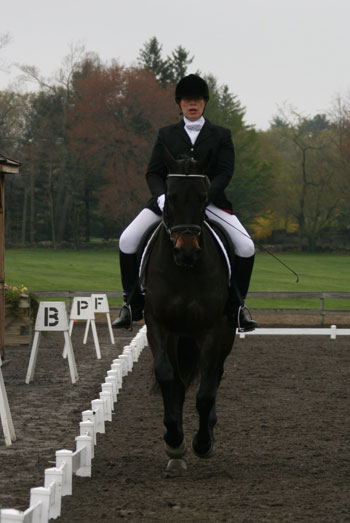Every four years, when a new set of USEF tests is issued, there is always a new twist or two that will take some time for the riders to figure out. One of those with the 2015 tests is the transition at First Level Test 3, from a lengthened canter back to working canter. The transition now happens at R and P, rather than at a corner letter or gradually through a corner or circle as it has in the past.

I judged at the GAIG/USDF regional championships in Region 9 at Houston, Texas, last weekend and saw that test done three dozen times while sitting at E, on the opposite side of the arena from where the lengthened canter was performed, so I had a really clear view of it. What I noticed, much more so than from my usual spot at C, was that most riders weren’t really doing the transition at R or P but more gradually going into the corners, just as they had in past tests. The top scores were so close that I suspect one key to winning a championship at this level was the difference between getting 7s or higher for doing those two transitions at the correct spot or a lower score for gradual transitions heading into the corners.
This is a clear instance where the judge sitting on the side might easily have a lower score than the judge at C, who can’t see the transitions so easily. Another is the First 3 trot pattern with a 10-meter circle at R, a halt at X, and then a 10-meter circle at V. I saw a lot of circles that simply weren’t centered on R/V or that drifted into 12-meter ovals. Many riders also wimped out on the turn at B, starting it early so that they weren’t anywhere near X for the halt. Those issues aren’t nearly so clear to the judge at C. Likewise, another judge commented to me that her side view of Training Level Test 3 showed a lot of 22-meter ovals (and bigger) for the canter circles at B/E in that test.
On the other hand, I also had a very clear view of the change of bend that precedes the first leg yield in First 3, starting at K, and I was pleased to see that very few riders seemed to have any trouble at all there. This is a big step forward from a similar change of bend in the round of tests from 2007-2010, We had four tests at First Level back then, and in First 3 there was a change of bend before V, followed by a leg yield to I. It seemed that very few riders entered that test if they could possibly avoid it, and that leg yield was the main reason. Then, when new tests came out in 2011, now with only three tests at First Level, that leg yield was made even harder since it started at K and required a change of bend in the corner itself. It may have taken five years to figure it out but the riders now seem very comfortable with it.
I suspect the same thing will happen over time with the transition at R/P out of the lengthened canter. One reason for that change was to make the riders actually set up the transition correctly rather than using the corner to bring the horse back. Yes, it may take a few steps to achieve the transition, but the judge should at least see a very different canter at B than she does by the time the horse arrives at M, rather than a conservative canter or a rocket blast that doesn’t change much at all between B and the corner that follows. If a rider can perform that transition with smoothness and clarity she stands to gain a lot of points that other riders in the test won’t earn.











